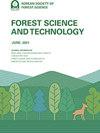Needs analysis and revitalization planning for School Forest Welfare Services using mixed method
IF 2.2
Q2 FORESTRY
引用次数: 0
Abstract
Abstract The purpose of this study is to identify the needs and suggest a revitalization plan for School Forest Welfare Services in Korea which is defined as “school-based services that provide forest education, forest healing, and cultural and recreational activities in the forest by creating, managing, and utilizing local or in-school forest environments to help children and adolescents develop and improve their quality of life.” To this end, using a mixed method, in-depth interviews and needs surveys were conducted with School Forest Welfare Service experts and teachers and parents of middle and high school students to understand the current status of School Forest Welfare Services and to identify their needs. As regards the current status, the environment for the services was assessed at the “middle” level while the forest welfare program was assessed at the “low” level. On the other hand, all the needs asked were found to be at a “high” level; especially, the needs for the “forest therapy” program, both for the selected group of and all students, were the strongest. In regard to revitalization, “programs linked to regular school curriculum,” “policies and budgets,” “green zone in school area,” and “expert supports by forest healing instructors and forest interpreters” were found to be demanded mostly. As a conclusion of the in-depth interviews and needs surveys, a plan to revitalize School Forest Welfare Services has been derived, which includes such objectives as; (1) to strengthen awareness of the necessity (assigning experts within the responsible institution to provide expertise, strengthening awareness among principals, teachers, and parents, and building social consensus with active publicity), (2) to prepare policy and legal basis, and (3) to establish a support system. This study was conducted to revitalize School Forest Welfare Services for adolescents in Korea, but it is hoped that School Forest Welfare Services will be developed and widely implemented for many children and adolescents around the world through diverse further studies.运用混合方法对学校森林福利服务进行需求分析与振兴规划
摘要:本研究的目的是确定韩国学校森林福利服务的需求并提出振兴计划,该服务被定义为“通过创造、管理和利用当地或学校的森林环境,提供森林教育、森林治疗和森林文化娱乐活动的学校服务,以帮助儿童和青少年发展和提高他们的生活质量。”为此,采用混合访谈法,对学校森林福利服务专家、初高中学生教师和家长进行深度访谈和需求调查,了解学校森林福利服务的现状,明确其需求。就目前的状况而言,服务的环境被评价为“中等”水平,而森林福利方案被评价为“低”水平。另一方面,所有被问及的需求都处于“高”水平;特别是,对“森林疗法”项目的需求,无论是对选定的群体还是对所有的学生,都是最强的。在振兴方面,被要求最多的是“与正规学校课程挂钩的项目”、“政策和预算”、“校园绿地”、“森林治疗指导员和森林翻译的专家支援”等。作为深入访谈和需求调查的结论,制定了一项振兴学校森林福利服务的计划,其中包括以下目标;(1)加强对必要性的认识(在责任机构内指派专家提供专业知识,加强校长、教师和家长的认识,并通过积极宣传建立社会共识);(2)准备政策和法律基础;(3)建立支持体系。本研究是为了振兴韩国的青少年学校森林福利服务而进行的,但希望通过进一步的多样化研究,学校森林福利服务能够在世界各地的儿童和青少年中得到发展和广泛实施。
本文章由计算机程序翻译,如有差异,请以英文原文为准。
求助全文
约1分钟内获得全文
求助全文

 求助内容:
求助内容: 应助结果提醒方式:
应助结果提醒方式:


